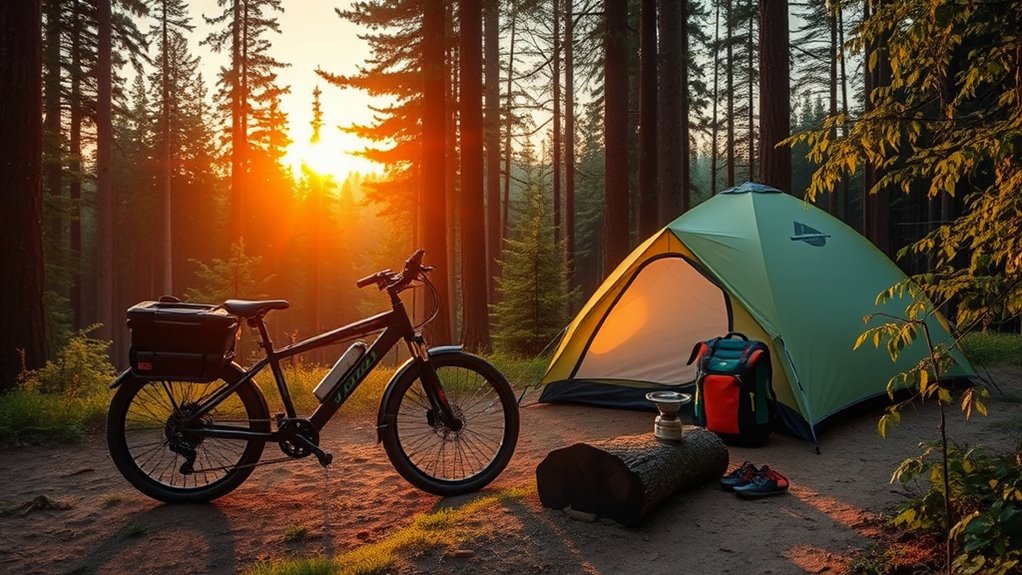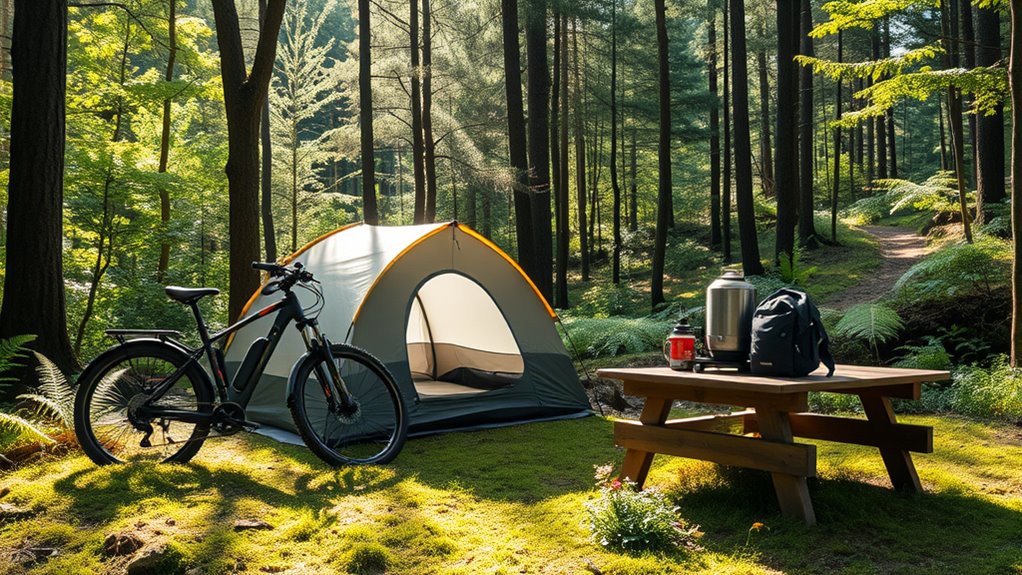To plan the perfect e-bike camping trip, check your bike’s tires, brakes, and battery to guarantee reliability. Pack lightweight, eco-friendly gear suited for weather changes, including essentials like clothing, food, and navigation tools. Choose routes that match your terrain and prepare for varying conditions with protective clothing and camping equipment. Stay safety-conscious with proper lighting and repair tools, and follow Leave-No-Trace principles. Keep exploring to discover detailed tips that will help you prepare smoothly.
Key Takeaways
- Plan your route considering terrain, weather, and distance; use GPS and maps for accurate navigation.
- Pack lightweight, eco-friendly gear suitable for outdoor conditions, including clothing, food, and camping essentials.
- Ensure your e-bike is fully charged, inspected, and equipped with necessary tools for on-the-go repairs.
- Prepare for varying weather and terrain with appropriate protective gear, and carry safety and emergency supplies.
- Follow eco-friendly practices, minimize environmental impact, and choose routes that promote conservation and responsible riding.

Ever wondered how to combine adventure with sustainability? E-bike camping makes it possible, offering an exciting way to explore the outdoors while reducing your carbon footprint. But to make your trip smooth and enjoyable, proper planning is essential, especially when it comes to bike maintenance and gear selection. Starting with bike maintenance, you want to guarantee your e-bike is in top shape before hitting the trail. Check the tire pressure and tread to prevent flats and maximize traction. Inspect the brakes and gears, making sure they respond well and shift smoothly. Don’t forget to charge the battery fully and carry a portable charger or extra battery if possible. Carrying basic tools like a multi-tool, tire levers, and a pump can save you from unexpected hiccups, especially when you’re miles away from help. Additionally, understanding the contrast ratio of your e-bike’s display can help you better see the screen in varying lighting conditions, ensuring safer navigation.
When it comes to gear selection, pack light but smart. Your main focus should be on essentials—clothing suitable for the weather, a compact first aid kit, navigation tools like maps or GPS, and enough food and water for your journey. Since you’re using an e-bike, choose gear that complements your riding style and the terrain. Lightweight panniers or a sturdy backpack will help distribute weight evenly, making your ride more comfortable. Consider investing in a waterproof cover for your gear to keep everything dry during unexpected rain. Think about the type of terrain you’ll encounter; if you’ll be riding on rough trails, opt for sturdy shoes, gloves, and protective gear like a helmet and knee pads. For camping, pack a lightweight tent, sleeping bag, and cooking equipment that won’t weigh you down but still cover your needs.
Frequently Asked Questions
What Safety Gear Is Essential for E-Bike Camping?
When considering safety gear, you need to prioritize helmet safety to protect your head during falls or accidents. Always wear a well-fitting helmet and consider additional trail protection gear like knee and elbow pads for rough terrain. Carry reflective gear or lights for visibility, especially if riding in low light. A first aid kit is also essential, so you’re prepared for minor injuries. Staying safe guarantees you enjoy your e-bike camping adventure worry-free.
How Do I Choose the Best Campsite for E-Bike Camping?
Choosing the best campsite can feel like finding a needle in a haystack, but it’s doable. You should look for campgrounds with great amenities, like charging stations and clean facilities, making your stay comfortable. Also, prioritize sites with stunning scenic views to enhance your experience. Check reviews and maps beforehand, ensuring the location’s terrain suits your e-bike’s capabilities and offers easy access for your daily adventures.
Can I Charge My E-Bike Batteries Off-Grid?
Yes, you can charge your e-bike batteries off-grid using solar charging setups or portable batteries. Solar chargers are portable and efficient, especially in sunny locations, allowing you to harness sunlight directly. Alternatively, portable batteries store energy that can be used to recharge your e-bike batteries when sunlight isn’t available. Carrying these options guarantees you stay powered up during your trip, giving you the freedom to explore without worrying about running out of battery.
What Maintenance Tasks Should I Perform Before a Trip?
Before your trip, you should inspect your tires for wear and proper inflation, check your brakes for responsiveness and sufficient pad life, and confirm your chain is clean and lubricated. Additionally, verify your battery charge level, tighten any loose bolts, and test your lights and signals. Taking these steps keeps your bike reliable, safe, and ready for adventure, so you can enjoy your ride without worries.
How Do Weather Conditions Affect E-Bike Camping Plans?
You should always check the weather forecast before your trip because it directly impacts your plans. Rain can make trail conditions muddy and slippery, increasing your risk of accidents, while high winds might make riding unsafe. Cold weather can affect battery life, so plan accordingly. By staying informed about trail conditions and weather updates, you’ll be better prepared to adapt your route or reschedule if needed, ensuring a safe and enjoyable ride.
Conclusion
Now that you’re armed with tips for e-bike camping, your adventure awaits like an open road calling your name. With careful planning and a sense of adventure, you’ll navigate nature’s playground effortlessly. Think of your trip as a symphony, each pedal stroke and campsite harmonizing perfectly. So gear up, embrace the journey, and let the great outdoors be your canvas—your perfect e-bike camping trip is just a ride away!









